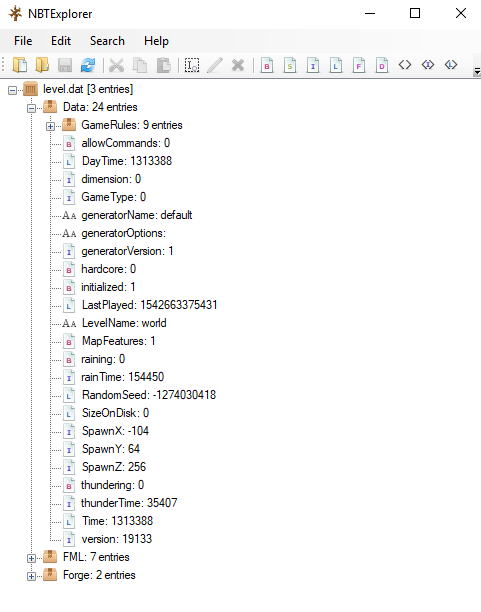

Click on the Byte Tag button on the top bar to add a new tag.Click on the tag compound to select it.Now you can change the level or the enchantment number to whatever you want. (Click the first item's tag and press CTRL + V.) You should see this: Then paste it in the first item's tag compound.

The first package inside this list contains a numerical ID for the enchant, and the level of the enchant. You can see it has an ench list in its tags. I have now navigated to the second item in the chest's Item list, which is my enchanted sword. There are many unobtainable or removed items, which are accessible here by typing their IDs.

It should look something like this: Name: minecraft:stick (or whatever the ID of your item is). This tag contains the item ID, so that Minecraft knows which item it is. In addition to the Name tag you see in the display properties, there is another Name tag outside the display properties. You can either use SHIFT + ENTER for new lines or add more string tags into the Lore list.ĭon't forget, always save! Unobtainable Items With that selected, click "String Tag" on the top bar and name it whatever you want your lore to say. It will default to NewList, name it Lore, then press ENTER to submit. On the top bar you should see an icon labelled "List Tag". You can also use the section sign § with formatting codes to further format your item name, like so: My NameĬlick ENTER to submit, and be sure to save your changes! ( CTRL + S) Go in game and you have a multi-line name on the item! LoreĬlick on the display subtag to select it. Press SHIFT + ENTER to insert a linebreak: Open it, and inside that, open the display subtag.ĭouble click the value (right side where it says Name), and then change it to what you want the name to be. Now you see the subtag called tag? This is why we put a name for our item earlier, we could make this ourselves but this is a lot easier. Now, go to the section below with the item property to modify: -If you already have located your item, start here- Multiline names Each of the other subtags under the Items list corresponds to a different slot of the chest. This will include all the tags of the item in the first slot of the chest. Then go into the Items and open the first subtag. Once here, you will see a subtag, in that there is a package named Level. In Universal MCE I use the chunk locator button to find the chunk, then clicked the chunk with my chest. Now open your NBT editor, and open the world. Once you have a template item, put the item in the chest and quit the game. So, I've enchanted a diamond sword with Knockback, and we can copy the enchantments list to our item in the NBT editor. If you want to add custom enchantments to an item, it will be much easier if you copy the enchantments list from another item. For example, if you want to change the item's custom name, you should first manifest an item's custom name by renaming it in an anvil. Item preparationīecause creating new NBT tags can be a quite complicated process, we'll have Minecraft create the tags we need for us, and then we'll edit them ourselves. I'm using Universal Minecraft Editor just because I got it a long time ago because some YouTuber I watched was using it, use anything you want. When in doubt, go to YouTube if you really can't figure something out.
#Add lore to item nbtexplorer how to
I won't tell you how to actually work these editors in this tutorial, but it should be self-explanatory. You can use VirusTotal to check a file online for viruses, just paste the URL into the input.Use a reputable one! Be careful as random EXEs on the internet can contain viruses! More Basic Properties (such as stack counts)ĭownload an NBT editor online.We hope that a new method will reveal itself in the new future.īesides for the chunk locating, everything after about modifying the data in the actual editor is still accurate and if you can circumvent the aforementioned bug it should still work.Īn NBT editor is able to manipulate the following item properties: There is currently no known way to edit NBT stored in the MCBE LevelDB format. This method used to work, but does not work anymore. To solve this problem, follow the method detailed here. UMCE has not been programmed to detect the new ChunkVersion tag, and hence, it does not detect any chunks. The problem has been traced back to changes to MCBE LevelDB format, mainly the move of ChunkVersion from value 118 to value 44. Currently, it only displays a blank white canvas instead of loading in chunks from your world. attention! Some of the instructions below no longer work with the Universal Minecraft Editor due to its broken chunk locator. New PacketAdapter(this, ListenerPriority.NORMAL,


 0 kommentar(er)
0 kommentar(er)
